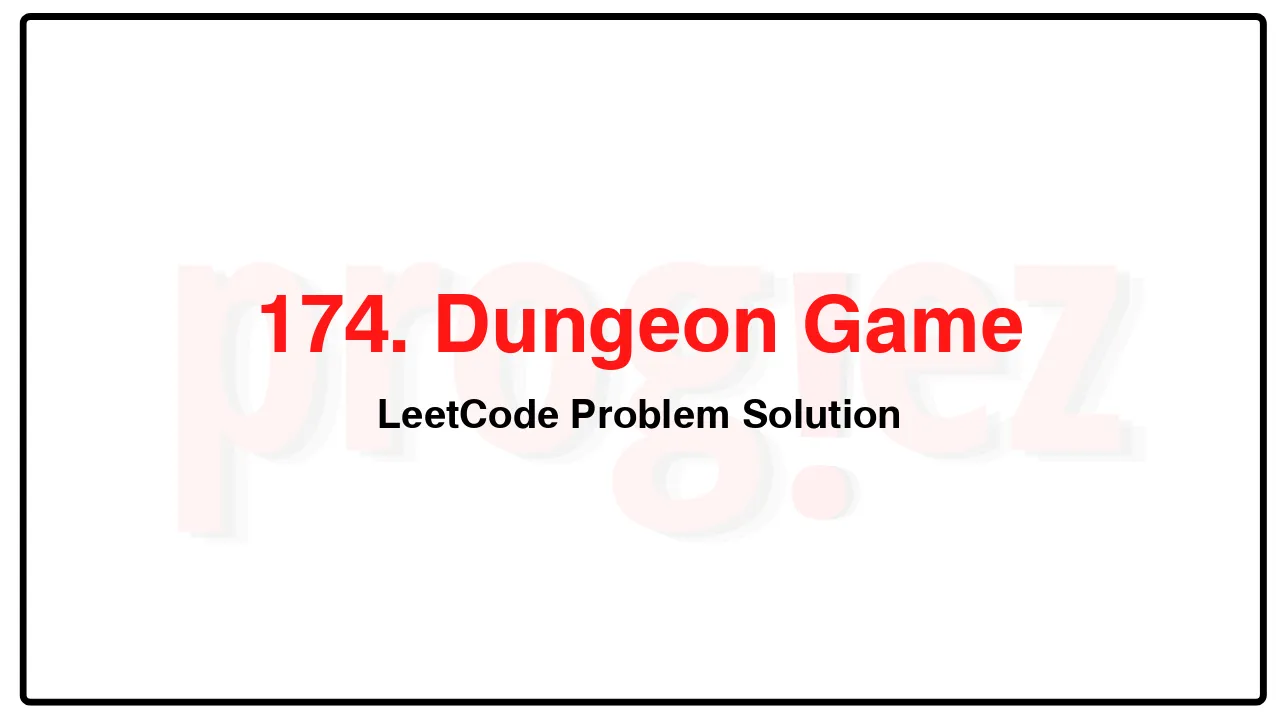174. Dungeon Game LeetCode Solution
In this guide, you will get 174. Dungeon Game LeetCode Solution with the best time and space complexity. The solution to Dungeon Game problem is provided in various programming languages like C++, Java, and Python. This will be helpful for you if you are preparing for placements, hackathons, interviews, or practice purposes. The solutions provided here are very easy to follow and include detailed explanations.
Table of Contents
- Problem Statement
- Complexity Analysis
- Dungeon Game solution in C++
- Dungeon Game solution in Java
- Dungeon Game solution in Python
- Additional Resources

Problem Statement of Dungeon Game
The demons had captured the princess and imprisoned her in the bottom-right corner of a dungeon. The dungeon consists of m x n rooms laid out in a 2D grid. Our valiant knight was initially positioned in the top-left room and must fight his way through dungeon to rescue the princess.
The knight has an initial health point represented by a positive integer. If at any point his health point drops to 0 or below, he dies immediately.
Some of the rooms are guarded by demons (represented by negative integers), so the knight loses health upon entering these rooms; other rooms are either empty (represented as 0) or contain magic orbs that increase the knight’s health (represented by positive integers).
To reach the princess as quickly as possible, the knight decides to move only rightward or downward in each step.
Return the knight’s minimum initial health so that he can rescue the princess.
Note that any room can contain threats or power-ups, even the first room the knight enters and the bottom-right room where the princess is imprisoned.
Example 1:
Input: dungeon = [[-2,-3,3],[-5,-10,1],[10,30,-5]]
Output: 7
Explanation: The initial health of the knight must be at least 7 if he follows the optimal path: RIGHT-> RIGHT -> DOWN -> DOWN.
Example 2:
Input: dungeon = [[0]]
Output: 1
Constraints:
m == dungeon.length
n == dungeon[i].length
1 <= m, n <= 200
-1000 <= dungeon[i][j] <= 1000
Complexity Analysis
- Time Complexity: O(mn)
- Space Complexity: O(mn) \to O(n)
174. Dungeon Game LeetCode Solution in C++
class Solution {
public:
int calculateMinimumHP(vector<vector<int>>& dungeon) {
const int m = dungeon.size();
const int n = dungeon[0].size();
vector<vector<int>> dp(m + 1, vector<int>(n + 1, INT_MAX));
dp[m][n - 1] = 1;
dp[m - 1][n] = 1;
for (int i = m - 1; i >= 0; --i)
for (int j = n - 1; j >= 0; --j) {
dp[i][j] = min(dp[i + 1][j], dp[i][j + 1]) - dungeon[i][j];
dp[i][j] = max(dp[i][j], 1);
}
return dp[0][0];
}
};
/* code provided by PROGIEZ */174. Dungeon Game LeetCode Solution in Java
class Solution {
public int calculateMinimumHP(int[][] dungeon) {
final int m = dungeon.length;
final int n = dungeon[0].length;
int[][] dp = new int[m + 1][n + 1];
Arrays.stream(dp).forEach(A -> Arrays.fill(A, Integer.MAX_VALUE));
dp[m][n - 1] = 1;
dp[m - 1][n] = 1;
for (int i = m - 1; i >= 0; --i)
for (int j = n - 1; j >= 0; --j) {
dp[i][j] = Math.min(dp[i + 1][j], dp[i][j + 1]) - dungeon[i][j];
dp[i][j] = Math.max(dp[i][j], 1);
}
return dp[0][0];
}
}
// code provided by PROGIEZ174. Dungeon Game LeetCode Solution in Python
class Solution:
def calculateMinimumHP(self, dungeon: list[list[int]]) -> int:
m = len(dungeon)
n = len(dungeon[0])
dp = [math.inf] * (n + 1)
dp[n - 1] = 1
for i in reversed(range(m)):
for j in reversed(range(n)):
dp[j] = min(dp[j], dp[j + 1]) - dungeon[i][j]
dp[j] = max(dp[j], 1)
return dp[0]
# code by PROGIEZAdditional Resources
- Explore all LeetCode problem solutions at Progiez here
- Explore all problems on LeetCode website here
Happy Coding! Keep following PROGIEZ for more updates and solutions.









